Set up Zenoti Payments for multiple legal entities in one center
This feature is currently in closed beta. Contact your Zenoti Representative to get the feature enabled.
This article explains how to manage multiple legal entities within a single center using Zenoti Payments. It covers how to enable separate invoicing, configure multiple merchant accounts, and process payments independently for each legal entity, ensuring accurate financial reporting and seamless payouts.
Overview
Zenoti Payments normally supports one merchant account per center, meaning all payments are processed through the same account and payouts are routed to the linked bank account. This creates challenges for businesses operating multiple legal entities in the same location.
This feature enables you to:
Support multiple legal entities in a single center.
Segregate invoicing, payments reporting, and payouts by business unit (BU).
Use a common payment terminal for different merchant accounts linked to the center.
Generate compliance, tax, and accounting reports for each BU (for example, Form 1099-K).
A medspa that offers spa, laser, and other related services as separate legal entities in the same location would otherwise have all payments flow into one account—creating compliance and reporting issues.
With this solution, Zenoti uses Business Units (BUs) to represent each legal entity. Businesses can now group products and services under distinct BUs and process payments separately for each BU using the merchant accounts linked to them.
How it works
Contact your Zenoti Representative to enable Separate invoicing and payment processing by Entity at the center level (this setting is disabled by default).
Assign all products and services to the appropriate BU.
Assign gift cards to a BU.
Go to Configuration > Gift Cards > Gift card settings.
Under Select a Business Unit for gift cards, choose the BU to link.
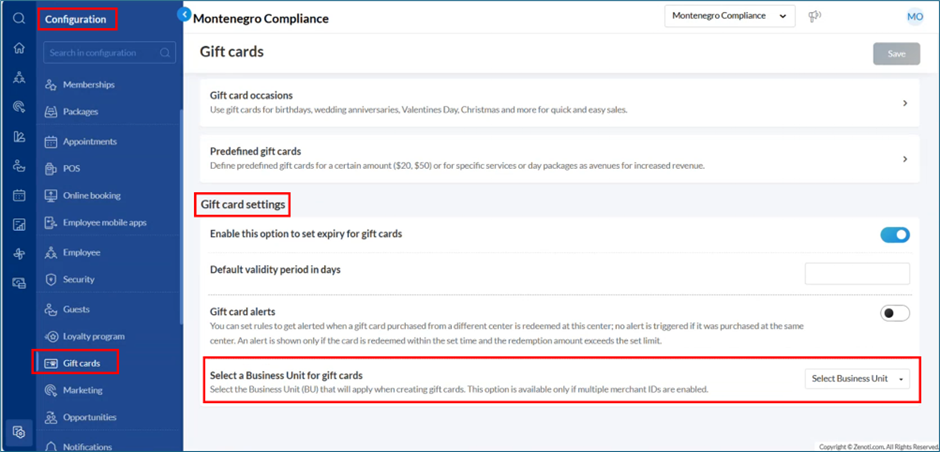
Create packages that may include products or services from multiple BUs but assign each package to one BU for payment routing.
Similarly, assign each membership to the BU against which payments are to be processed.
Create multiple merchant accounts, one for each of the BU, and link them to a specific center (refer to the Onboard to Zenoti Payments article).
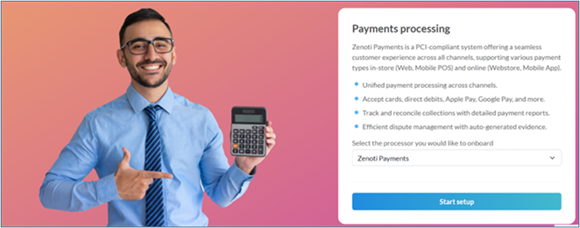
Map each BU to one merchant account. Multiple BUs can share a merchant account, but ensure each BU has one linked account.
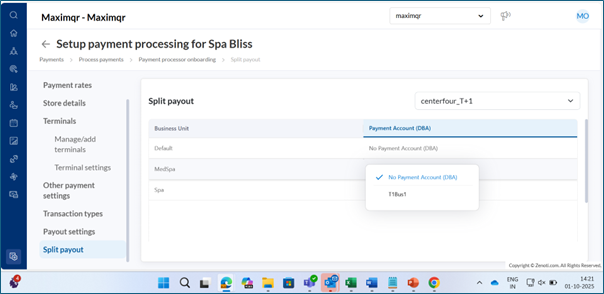
Onboard payment terminals for any merchant account linked to the center.
Note
Zenoti routes each transaction to the merchant account linked to the BU of the invoice.
If a BU has no linked account, Zenoti displays the error Can’t process payment. The Business Unit is not linked to any payment account.
Each invoice must include items from a single BU. If items belong to multiple BUs, the front desk must split them into separate invoices before taking payment.
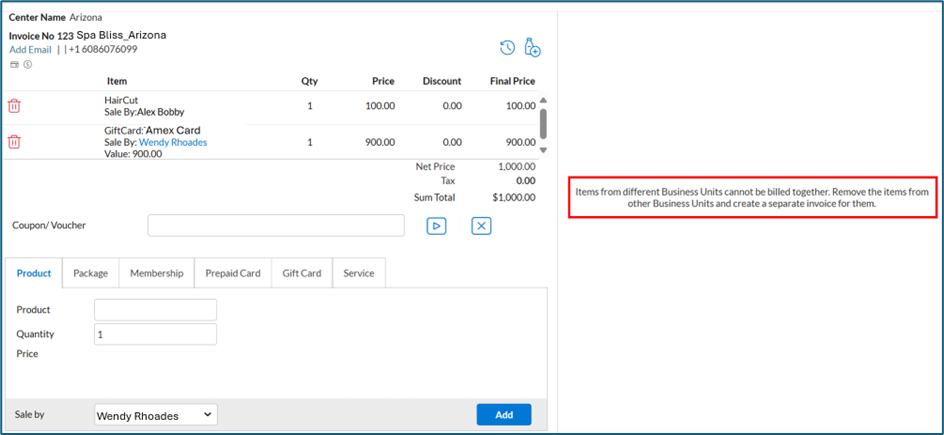
BU level data appears in payments reports such as Digital Payments and Bank Deposit Report.
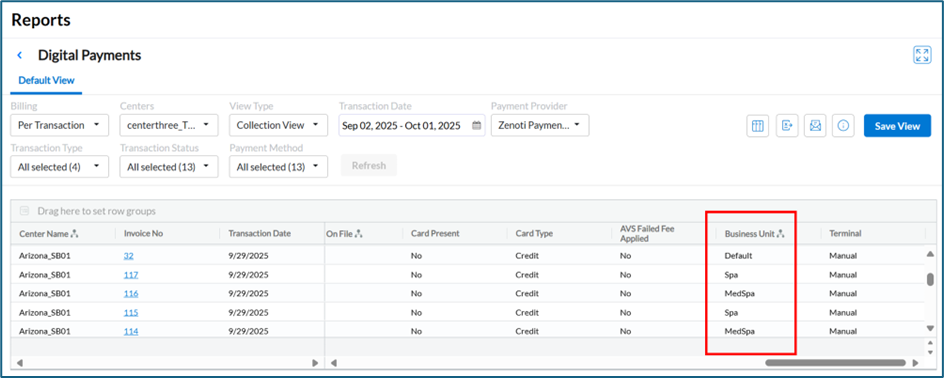
Note
This capability is available for Zenoti customers using Adyen or Stripe.
Online and in-store sales behavior
Item type | In-store sales | Online sales |
|---|---|---|
Products and services | Create invoices only with items from one BU; split invoices if items belong to different BUs. | Guests book multiple services at once, but deposits are not supported; invoices must be split by BU at checkout. |
Memberships | Sell memberships only for the BU they are assigned to. | Guests buy one membership at a time; payment routes to the linked BU. |
Packages | Sell packages only for the BU they are assigned to. | Guests buy one package at a time; payment routes to the linked BU. |
Gift cards (sale and redemption) | Sell gift cards only for the BU they are assigned to. Redemption of gift cards isn’t restricted to the BU against which they were sold. | Guests purchase normally; payment routes to the linked BU. |
User responsibilities in multi-BU payments
Multi-entity payments impact each user group in specific ways:
Admins set up BUs, assign products, services, packages, memberships, and gift cards, and map merchant accounts to each BU. Packages may include items from multiple BUs, but each package must still be linked to one BU.
Front desk staff create invoices with products or services belonging to one BU. If services in a booking belong to different BUs, split them into separate invoices so each route to the correct merchant account. Staff can use the same payment terminal for all BUs.
Finance managers review BU-level reports and reconcile payouts.
Webstore guests experience the following:
Services or Day packages: Guests may book multiple services, but service deposits are not supported.
Memberships: Guests buy one membership per invoice; settlement is done for a single BU.
Gift cards: All gift cards are mapped to one BU; purchases settle to that BU.
Series packages: Guests buy only one series package per invoice; the Add another Series package button is hidden when multi-BU payments are enabled.
Limitations
The Webstore restricts series package purchases to one per invoice to ensure settlement against a single merchant account (MID).
Service deposits aren’t supported under this model disable collection of service deposits.
Frequently asked questions (FAQs)
Q: Why can’t I add more than one series package online?
A: Zenoti restricts selling of multiple series packages in one invoice because the packages may belong to different BUs.
Q: What happens if I assign items to the wrong BU?
A: Payments and payouts for those items route to the wrong merchant account. Update the BU mapping in Master data, then regenerate invoices if needed.
Q: Can I process a single invoice with services from multiple BUs?
A: No, each invoice must contain items from a single BU. Split the invoice before taking payment.
Q: Are gift cards linked to one BU or multiple BUs?
A: All gift cards are assigned to one BU to keep settlement consistent.
Q: How does dispute management work for centers with multiple BUs?
A: Disputes are tracked at the each merchant account level. When a dispute is raised for a transaction, Zenoti links it to the merchant account that processed the original payment so you can review and respond within the correct business unit’s records.
Key terms
Term | Description |
|---|---|
Legal entity | The actual business registered for compliance and tax purposes. |
Business unit (BU) | Note: In this context, a Business Unit (BU) represents a legal entity within a center. It is the operational mapping in Zenoti used for payments, reporting, and invoicing. |
Dispute management | Managing chargebacks and disputes at the BU level. |